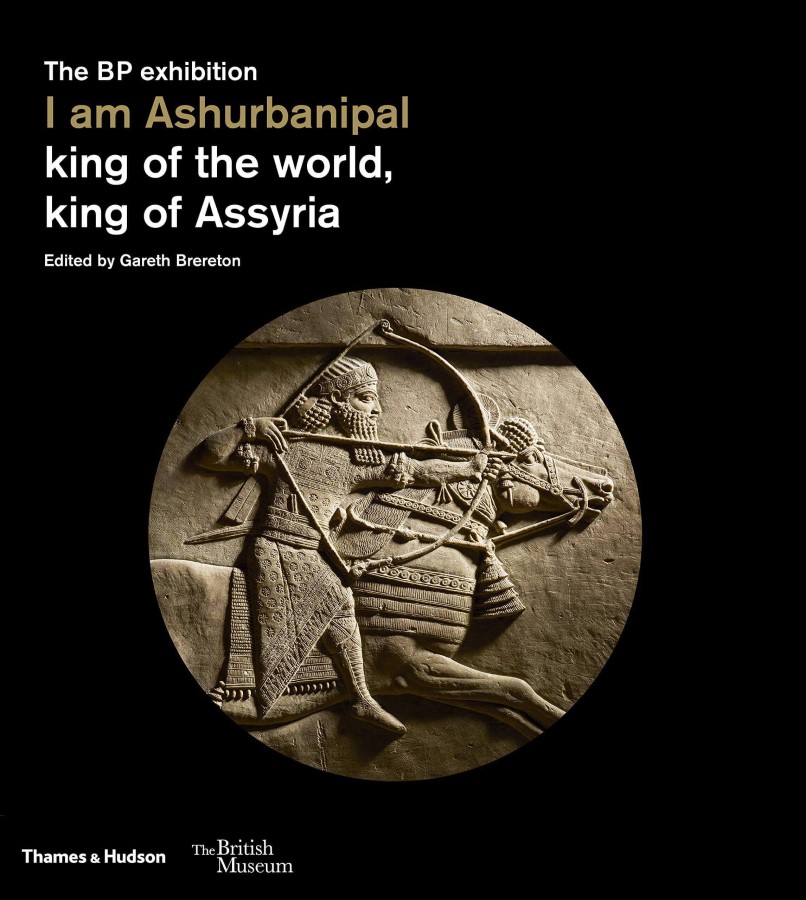
Review of the catalogue and exhibition of the Assyrian king Ashurbanipal at the British Museum in London
On his ascent to the throne in 669 BC, the Assyrian king Ashurbanipal was the most powerful individual on the planet. From his capital in Nineveh, situated east of the River Tigris in the northern region of present-day Iraq, Ashurbanipal ruled over an empire stretching from the banks of the Nile in Egypt to the mountains of western Iran, and from the shores of the Persian Gulf to the plains of the central Anatolian steppe.
Until February 24, 2019 the British Museum shows the exhibition I am Ashurbanipal: king of the world, king of Assyria (Amazon.co.uk, Amazon.com, Amazon.fr, Amazon.de) with over 200 objects from all corners of the Assyrian empire which document his reign. Massive stone sculptures, carved reliefs, wall paintings, painted glazed bricks, cosmetic vessels, carved ivories, extravagant metalwork, gold ornaments, ornate chariot fittings, elaborate weaponry and other items document his period.
Ashurbanipal claimed that unlike his predecessors he could read, write and debate with expert scholars. He had assembled the greatest library in existence during his reign which helped him manage his empire. Hundreds of cuneiform texts have survived and allow archaelogists, historians and other specialists to better understand the king and his time.
Ashurbanipal conquered Egypt, inflicted a crushing defeat to his rebellious older brother and was responsible for many ruthless campaigns against all who defied his rule. He was the last great king of Assyria. Nineveh, now located within modern Mosul, was the largest city in existence at the time.
Sources are virtually non-existent for the final years of Ashurbanipal’s reign; the latest datable inscriptions date from c. 638 BC. It is unknown how and when the king died (most likely beween 631 and 627 BC).
The exhibition and/or catalogue explore Ashurbanipal’s Palace at Nineveh, lift at court, the Assyrian Royal hunt, the contents and the significance of the king’s library, knowledge as the key to Assyrian power. The section dedicated to Assyria in the world explores the Empire’s relation with the levant, Cyprus, the Kingdom of Urartu, Western Iran, Susan and the Kingdom of Elam and more. Another section is dedicated to Ashurbanipal’s military campaigns and battles and the understanding of his palace reliefs. The last section is heteroclite and presents the fall of Assyria and the aftermath of the empire, the modern-day rediscovery of Nineveh, the Assyrian revival and the future of the Iraqi cultural heritage.
Unfortunately, Daesh (IS) systematically targeted and destroyed important archaeological sites in Iraq such as Nineveh and Nimrud. In response to this barbarian act, the British Museum developed the Iraq Emergency Heritage Management Training scheme to train Iraqi archaeologists in rescue archaeology and emergy heritage management. The very last section of the exhibition is dedicated to this project.
In addition to the Ashurbanipal temporary exhibition, do not forget to have a look around the permanent Assyrian exhibition at the British Museum which is equally impressive!

The exhibition catalogue
Gareth Brereton, ed.: I am Ashurbanipal: king of the world, king of Assyria. British Museum, Thames and Hudson Ltd. November 2018, 348 pages. Order the richly illustrated hardcover book from Amazon.co.uk, Amazon.com, Amazon.fr and Amazon.de.
Article added on January 28, 2019 at 16:00 Ukrainian time. Additional info added at 17:04.